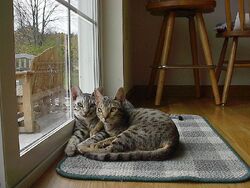| Ocicat | ||
|---|---|---|
 | ||
| Information | ||
| Origin |
United States | |
| Common Nicknames |
Ocicat | |
| Breed Standard | ||
| FIFe | ||
| CFA | ||
| TICA | ||
| AACE | ||
| ACF | ||
| CCA | ||
| Cat (Felis catus) | ||
| List of Cat Breeds | ||
The Ocicat is an all-domestic breed of cat which resembles a 'wild' cat but has no wild blood. The breed is unusual in that it is spotted like a wild cat but has the temperament of a domestic animal. It is named for its resemblance to the ocelot.
Despite its appearance, there is no 'wild' DNA in the Ocicat's gene pool. The species is actually a mixture of Siamese and Abyssinian, and later American Shorthairs (silver tabbies) were added to the mix and gave the breed their silver color, bone structure and distinct markings.
History[]
The first breeder of Ocicats was Virginia Daly, of Berkley, Michigan, who attempted to breed an Abyssinian-pointed Siamese in 1964. The first generation of kittens appeared Abyssinian, but the surprising result in the second generation was a spotted kitten, Tonga, nicknamed an 'ocicat' by the breeder's daughter. Tonga was neutered and sold as a pet, but further breedings of his parents produced more spotted kittens, and became the basis of a separate Ocicat breeding program. Other breeders joined in and used the same recipe, siamese to aby, and offspring to siamese. The American Shorthair was later introduced to the Ocicat giving the breed stripes with spots. The Ocicat was initially accepted for registration in The Cat Fanciers' Association, Inc., and was moved into Championship for showing in 1987. Other registries followed. Today the ocicat is found all around the world, popular for its temperament but wild appearance.
Behavior[]
Ocicats are a very outgoing breed. They are often considered to have the spirit of a dog in a cat's body. Most can easily be trained to fetch, walk on a leash and harness, come when called, speak, sit, lie down on command and a large array of other dog-related tricks. Most are especially good at feline agility because they are very toy-driven. Some even take readily to the water. Ocicats are also very friendly. They will typically march straight up to strangers and announce that they'd like to be petted. This makes them great family pets, and most can also get along wеll with animals of other species, although they are likely to assert their dominance over all involved. Ocicats make excellent pets for people who want to spend a lot of time with their cat, but they do require more attention than cats who are not so people-oriented. Given the chance, an Ocicat will climb onto your neck and shoulders, and be transported around your home and garden. They have very powerful claws, so beware of delicate fabrics.
Coloring[]
There are twelve colors approved for the ocicat breed. Tawny, chocolate and cinnamon, their dilutes, blue, lavender and fawn, and all of them with silver: black silver (ebony silver), chocolate silver, cinnamon silver, blue silver, lavender silver and fawn silver.
